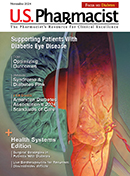US Pharm. 2010;35(7):17-18.
Disruptive Pauses in Breathing During Sleep
Sleep apnea is a disorder in which restful sleep is disrupted throughout the night by pauses in the normal pattern of breathing. This may lead to short periods when deep sleep is interrupted and a lighter sleep results, or even awakening with a cough or choking sound. Sleep apnea is one of the leading causes of daytime sleepiness. Many people who suffer from sleep apnea are unaware they have this problem.
There are three types of sleep apnea: obstructive, central, and complex (a combination). In obstructive sleep apnea, normal breathing is interrupted during sleep as a result of a narrowed or blocked airway, usually due to a relaxation of muscles in the throat. When oxygen levels are low, the brain wakes the body to restart breathing. Obesity and smoking are two of the most significant risk factors for obstructive sleep apnea. In central sleep apnea, the signal to breathe is not sent properly from the brain to the breathing muscles. Heart problems or stroke have been linked to central sleep apnea.
Because the patient may not be aware of the problem, sleep apnea is sometimes difficult to diagnose. Although a physician cannot test for this condition during an office visit, a definite diagnosis can be made with an overnight sleep study (polysomnogram) in a special sleep laboratory.
There are no specific medications to treat sleep apnea, and no proven cure that works for every patient. Changes in lifestyle (e.g., losing weight, smoking cessation, avoiding alcohol) can help mild cases of sleep apnea. A dentist can make a custom mouthpiece to adjust the jaw and tongue so that the patient’s airway remains open during sleep. In more serious cases, a breathing mask known as a continuous positive airway pressure (CPAP) device is worn during sleep to blow pressurized air into the throat and keep it open. If all these treatments are unsuccessful, surgery has been used in certain cases to remove extra tissue in the mouth or throat or to reset the position of the jaw to widen the air passage.
Daytime Drowsiness Is the Primary Symptom of This Disorder
Sleep apnea is a sleep disorder that affects millions of Americans, although many are unaware of the problem. This is because the primary symptom of sleep apnea is significant daytime drowsiness with adequate sleep time, which can also occur in disorders such as narcolepsy. Other symptoms include snoring, choking, awaking during the night, and waking with a headache, sore throat, or dry mouth.
Diagnosing the Problem
As age increases, the risk of sleep apnea increases. This is likely due to the inability of the brain to properly signal the throat muscles to keep the airway open during sleep. Sleep apnea is more common in men than in women, and smokers are also more likely to suffer from the disorder. The biggest risk for the development of sleep apnea is excess weight, which leads to an increase in fatty tissue around the airway. Less commonly, a patient may have enlarged tonsils or a facial structure that results in a smaller airway.
There are no specific tests to diagnose sleep apnea. Usually a patient is unaware of the reason for excess daytime sleepiness. A family member may complain about the patient snoring, choking, or awakening in a startled manner. The doctor can perform a physical examination and refer the patient to an ear, nose, and throat specialist to pinpoint the problem. If central sleep apnea is the diagnosis, a cardiologist or neurologist may be consulted. A sleep specialist can perform a polysomnogram, which requires an overnight stay to record breathing, oxygen levels, heart activity, eye movements, and brain activity during sleep.
Treatment Options
The goal for treatment of sleep apnea is to restore normal, restful sleep by treating the underlying cause of the sleep disturbance. In patients with obstructive sleep apnea, the goal is to keep the airway open during sleep. The choice of treatment depends in part on the reason the airway is blocked. Weight loss and/or smoking cessation is recommended if appropriate. Next steps in treatment include the use of a device that keeps the airway open. Custom dental devices are available that hold the jaw and tongue in place to avoid airway narrowing or blockage. In moderate or severe cases, a continuous positive airway pressure (CPAP) device is used. The CPAP machine delivers air under pressure through a mask worn over the mouth and/or nose during sleep. The pressure of the air is just forceful enough to keep the airways open. Although some people have a difficult time adjusting to the CPAP device, there are several styles available, and adjustments can be made. If one of these devices is not effective, the patient may benefit from surgery to remove excess tissue from the upper airways.
Treatment for central sleep apnea is focused on treating any heart or nervous system disorder that is causing the problem. Breathing supplemental oxygen at night may be useful in this type of sleep apnea. Patients who suffer from complex sleep apnea can be treated in a similar manner to obstructive sleep apnea.
Consequences of Poor Sleep
Sleep apnea should never be ignored. Untreated, it can lead to serious complications such as hypertension, heart attack, stroke, and problems undergoing surgical procedures that require anesthesia. Daytime sleepiness is another serious consequence of sleep apnea. In addition to poor performance in everyday activities, daytime sleepiness is clearly a risk for accidents at work, in the car, or at home.
To comment on this article, contact rdavidson@uspharmacist.com.






